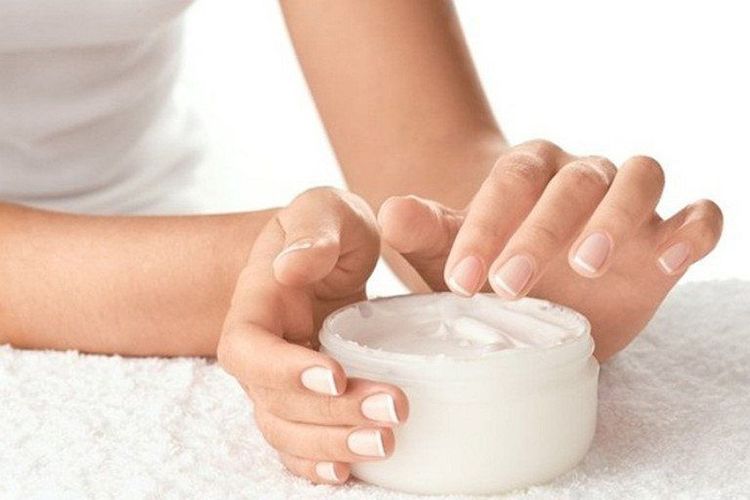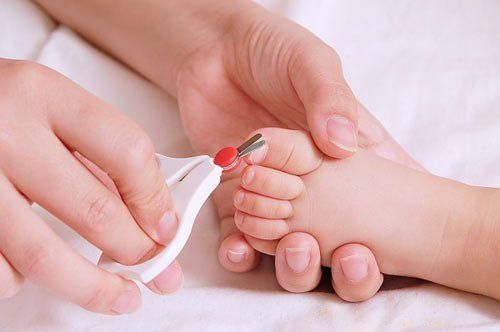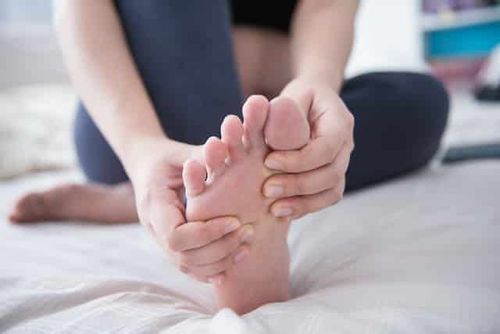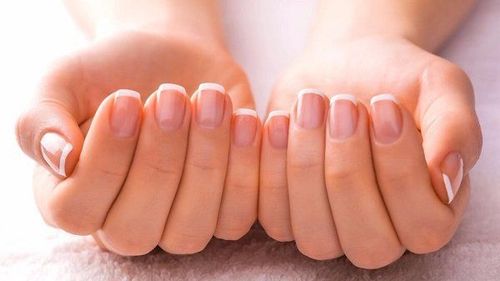This is an automatically translated article.
This article is professionally consulted by resident Doctor Le Thanh Tuan - Gastroenterologist - General Surgery Department - Vinmec Nha Trang International General Hospital.Cutting toenails that are too short (or toenails that grow too long) and wearing shoes or socks that are too tight can cause painful ingrown toenails. Soak the affected foot and remove pressure on the toe to help speed recovery. Take your child to the doctor if there are signs of an infection or the toenail is not improving.
1. What is an ingrown toenail?
An ingrown toenail, also known as an ingrown toenail, is a condition in which the toenail, instead of growing straight and lengthening forward, grows horizontally or even obliquely into the flesh and skin surrounding the nail. Ingrown toenails can happen to any toe, but the big toe is the most common.You can cure yourself by trimming the nail edge regularly after a foot bath if your child's ingrown toenail is mild. If left untreated, severe ingrown toenails can lead to serious skin and bone infections in children.
Children are the most susceptible to ingrown toenails because they often cut their toenails incorrectly, wear shoes that are too tight....make their toes constricted.
Besides, the elderly are also very susceptible to ingrown nails because the reason is that our toenails tend to become thicker with age, so the toenails of the elderly tend to be ingrown.
2. How do I know if my child has an ingrown toenail?
Signs of an ingrown toenail in children include:Redness or swelling of the skin at the edge of the toenail Pain: the child may cry and pull on his toes or feet. Or the child may limp or wince as he walks. If the toe becomes infected, the toe may appear pus or discharge.
Some other symptoms may not be mentioned. Consult your doctor, if you have any questions about the signs of illness, consult your doctor.

3. How do I know if an ingrown toenail is infected?
Signs of an infected ingrown toenail in children include:A blister containing white or yellowish fluid, surrounded by red skin - if the blister is broken, there is There may be some discharge Increased swelling or redness as the nail grows Increased pain The surrounding skin is red Red spots appear on the toes Smelly toes The child has a fever .
4. Caring for a child with an ingrown toenail
Ingrown toenails usually improve within a few days after you take the following steps:Soak your child's feet in warm (not hot) soapy water for about 10 to 20 minutes two or three times a day. Adding Epsom salt to water can help relieve pain. Then, dry your feet and apply an over-the-counter antibiotic ointment or cream to the problem area. Eliminates pressure of the nail on the surrounding skin. Try filing the toenail gently away from the skin. If possible, use one of your fingernails to gently lift the toenail and insert some sterile cotton or gauze between the nail and the skin. Use just enough to lift the nail a little and change the cotton several times a day. Let children go barefoot. When you go out, have your child wear loose-fitting shoes or sandals until the toe heals, but at home leave your child barefoot. Pain relief. If ingrown toenails really bother your child, consider giving him an over-the-counter pain reliever, such as acetaminophen or ibuprofen (if he's 6 months or older). (If your baby is under 3 months old, ask your doctor before giving him anything.) Ask your doctor if a toe protector might help. Over-the-counter protectors provide a cushion around the ingrown nail. Some contain medicinal gels that soften the toenails.

5. What causes ingrown nails?
Children can have ingrown toenails for a number of reasons such as:Cut toenails too short Having toenails that are too long or tend to curve down Wearing shoes or socks that are too tight. Pinched shoes, especially in the front, can compress the toes and lead to ingrown nails. Even socks that are too tight can push a child's toenail into a child's toes. Congenital abnormality of the toe bones Trauma to the toe Toenails repeatedly hitting the toe (like when kicking a soccer ball) Having damaged and falling off toenails. New nails are more likely to be ingrown than existing nails.
6. How to prevent children from getting ingrown toenails?
Regularly check the fit of your child's shoes.You need to make sure that your child is not wearing shoes or socks that are too long. Here's how to check your child's shoes:
When the child is standing, you can squeeze your little finger between the heel and the heel of the shoe, and there should be enough thumb width between the end of your child's longest toe and the front of the shoe. Check the material of the shoe (if it is soft enough). When buying shoes, buy in a larger size, because children's feet will swell, this trend increases at night. A shoe that fits well in the morning can be a little tight at night. Let your child wear new shoes in the house for about 15 minutes, then take them off and look for irritated areas on their feet. This is especially helpful for babies or toddlers who can't tell you when a toe hurts. Trim your child's toenails properly
Soaking your child's feet in warm water - such as in the shower - works before trimming the toenails. This will soften the nail, making it easier to cut. Make sure to cut your child's fingernails horizontally - not in a circle. You may find it easier to do this with a toenail clipper than a clipper, but use whichever gives you the most control. Trim your child's toenails before they are long enough to break on their own, for example by putting on a sock. If the toenail is torn, the remaining short portion may become ingrown. Don't cut your child's toenails too short. Leave a bit of white at the end of the nail, and gently file the edges if they are too sharp. If your child refuses to trim his toenails, do it while he's asleep. If the ingrown toenail doesn't improve after about a week of home treatment, see a doctor. Call the doctor sooner if your child is in pain or if the skin shows signs of infection.

7. Ingrown toenail treatment?
To treat an ingrown toenail, your doctor will do the following:Test the fluid if there is pus or a blister to look for different types of bacteria. Prescribe oral or topical antibiotics if there is an infection around the nail. Treat your child's toenail by inserting cotton or dental floss under the nail to relieve pressure. Trim a toenail that affects the skin or remove part of the toenail if other measures don't work. Refer you to your pediatrician, if the problem is severe. One thing to keep in mind when a child has an ingrown toenail is that you need to trim your child's nails correctly - not too long, not too short and straight across. However, trimming newborn toenails properly can be more difficult than in other children. Parents of children with ingrown toenails need to regularly monitor their children and seek medical attention immediately if the child shows signs of infection. Vinmec is a reputable examination and treatment address with a sterile operating room system to avoid hospital infections.
As a key area of Vinmec Health system, Pediatrics Department always brings satisfaction to customers and is highly appreciated by industry experts with:
Gathering a team of top doctors and nurses in Pediatrics : consists of leading experts with high professional qualifications (professors, associate professors, doctorates, masters), experienced, worked at major hospitals such as Bach Mai, 108.. Doctors All doctors are well-trained, professional, conscientious, knowledgeable about young psychology. In addition to domestic pediatric specialists, the Department of Pediatrics also has the participation of foreign experts (Japan, Singapore, Australia, USA) who are always pioneers in applying the latest and most effective treatment regimens. . Comprehensive services: In the field of Pediatrics, Vinmec provides a series of continuous medical examination and treatment services from Newborn to Pediatric and Vaccine,... according to international standards to help parents take care of their baby's health from birth to childhood. from birth to adulthood Specialized techniques: Vinmec has successfully deployed many specialized techniques to make the treatment of difficult diseases in Pediatrics more effective: neurosurgery - skull surgery, stem cell transplantation. blood in cancer treatment. Professional care: In addition to understanding children's psychology, Vinmec also pays special attention to the children's play space, helping them to have fun and get used to the hospital's environment, cooperate in treatment, improve the efficiency of medical treatment. If there is a need for medical examination with experienced pediatricians at Vinmec, please book an appointment on the website to be served.
Please dial HOTLINE for more information or register for an appointment HERE. Download MyVinmec app to make appointments faster and to manage your bookings easily.
Reference source: babycenter.com









